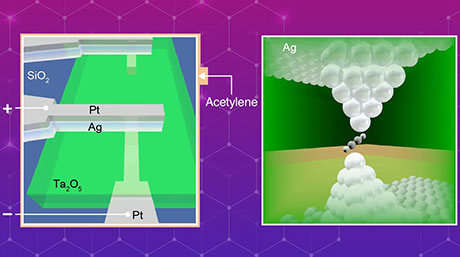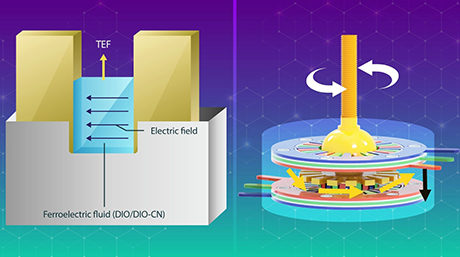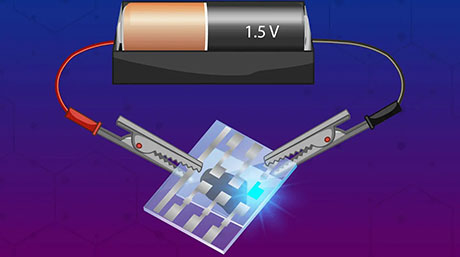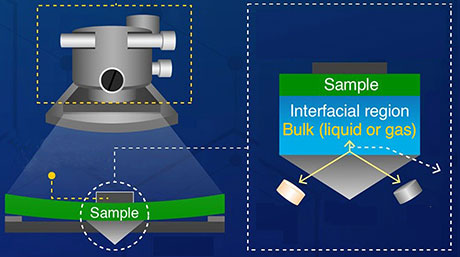Materials Science and Engineering News
Artificial intelligence accelerates the development of advanced heat-dissipating polymers
Machine learning approach predicts liquid crystalline polymers with high thermal conductivity
A machine learning method developed by researchers from Institute of Science Tokyo, the Institute of Statistical Mathematics, and other institutions accurately predicts liquid crystallinity of polymers with 96% accuracy. They screened over 115,000 polyimides and selected six candidates with a high probability of exhibiting liquid crystallinity. Upon successful synthesis and experimental analyses, these liquid crystalline polyimides demonstrated thermal conductivities up to 1.26 W m-1 K-1, accelerating the discovery of efficient thermal materials for next-generation electronics.
Developing the World’s First Machine Learning-Assisted Liquid Crystalline Polymers with High Thermal Conductivity
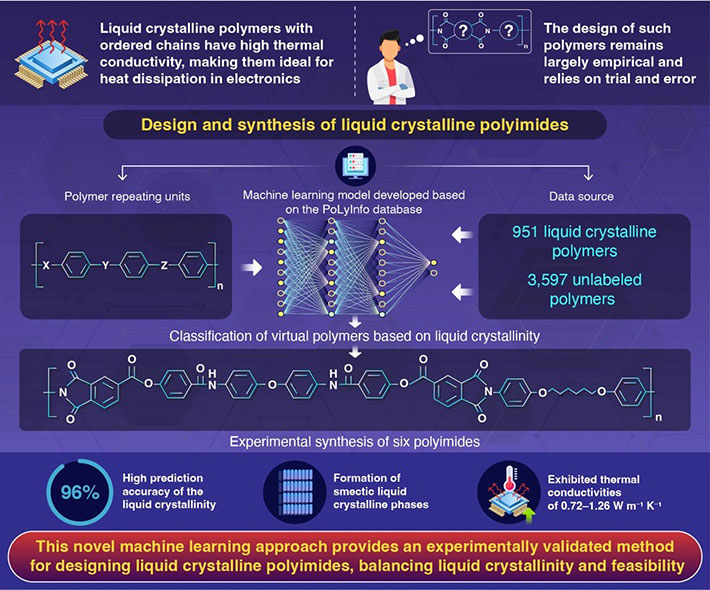
Discovery of liquid crystalline polymers with high thermal conductivity using machine learning![]()
Maeda et al. (2025) | npj Computational Materials | 10.1038/s41524-025-01671-w
Finding new polymer materials that can efficiently dissipate heat while maintaining high reliability is one of the biggest challenges in modern electronics. One promising solution is liquid crystalline polyimides, a special class of polymers whose molecules naturally align into highly ordered structures. These ordered chains create pathways for heat flow, making liquid crystalline polyimides highly attractive for thermal management in semiconductors, flexible displays, and next-generation devices. However, designing these polymers has long relied on trial and error because researchers lacked clear design rules to predict whether a polymer would form a liquid crystalline phase.
In a breakthrough, researchers from Institute of Science Tokyo (Science Tokyo), the Institute of Statistical Mathematics (ISM), and other institutions across Japan developed a machine learning model that can successfully predict which polyimide structures will form liquid crystalline phases, a world-first in polymer materials research. The team then successfully synthesized these polymers, confirming that they formed smectic liquid crystalline phases and demonstrated in-plane thermal conductivities significantly higher than conventional polyimides.
The study, which marks a significant step forward in data-driven polymer design, was published online in Volume 11 of the journal npj Computational Materials on July 02, 2025. It was led by Professor Junko Morikawa (Science Tokyo) as Principal Investigator, with Professors Teruaki Hayakawa (Science Tokyo) and Ryo Yoshida (ISM) as key collaborators. The project was primarily driven by Associate Professor Stephen Wu (ISM) and graduate students Mr. Hayato Maeda and Ms. Shiori Nakagawa (Science Tokyo).
“This study marks an important step forward in using machine learning for polymer development, showing it can successfully identify liquid crystalline polymers with high thermal conductivity,” explains Hayakawa.
The model, developed by Yoshida’s group, functions as a binary classifier: given a polymer’s chemical structure, it predicts whether the polymer will form an ordered liquid crystalline state or not, achieving an impressive 96% classification accuracy. To train the model, the researchers used PoLyInfo, a comprehensive polymer property database from the National Institute for Materials Science, that includes 951 polymers confirmed to form liquid crystalline phases and 3,597 unlabeled polymers. From these data, the model learned to recognize the chemical, physical, and structural properties that enable a polymer to self-assemble into an ordered phase.
The team then used the model to screen for desirable liquid crystalline properties in polyimides, a family of high-performance plastics known for withstanding high temperatures and being used as insulating materials in electronics and aerospace applications.
To generate realistic candidates, the researchers created a virtual library by breaking the polyimide template designed by Hayakawa’s group into five basic building blocks. By combining different pairs of acid dianhydrides and diamines—the molecular fragments that make up polyimide chains—they generated over 115,000 possible structures.
The model screened this virtual library and predicted more than 10,800 polyimide candidates with a high likelihood of forming liquid crystalline phases. From these, the researchers synthesized six diverse examples, forming smectic liquid crystalline phases. The thermal conductivities of these polyimides, measured by Morikawa’s group, ranged from 0.72 to 1.26 W m-1 K-1. The researchers found that polyimides with more rigid molecular structures and better in-plane alignment showed higher thermal conductivity, offering insights into preferred molecular structures.
“This achievement is the first of its kind in polymer materials research, where liquid crystalline polymers were discovered using machine learning. Our method could pave the way for investigating not only liquid crystalline polyimides but also other classes of liquid crystalline polymers,” says Yoshida.
This method is an emerging trend of using machine learning for material design, transforming into rapid, data-driven exploration. It points to a future of designing materials with tailored properties in a computer and verifying them in a fraction of time.
- Reference
| Authors: | Hayato Maeda1, Stephen Wu2,3, Rika Marui1, Erina Yoshida1, Kan Hatakeyama-Sato1, Yuta Nabae1, Shiori Nakagawa1, Meguya Ryu1,4, Ryohei Ishige1, Yoh Noguchi5,2, Yoshihiro Hayashi2,3, Masashi Ishii6, Isao Kuwajima6, Felix Jiang7, Xuan Thang Vu7, Sven Ingebrandt7, Masatoshi Tokita1, Junko Morikawa1,8*, Ryo Yoshida2,3,6,9*, and Teruaki Hayakawa1* |
|---|---|
| Title: | Discovery of liquid crystalline polymers with high thermal conductivity using machine learning |
| Journal: | npj Computational Materials |
| DOI: |
10.1038/s41524-025-01671-w |
| Affiliations: |
1School of Materials and Chemical Technology, Institute of Science Tokyo, Japan 2The Institute of Statistical Mathematics, Research Organization of Information and Systems, Japan 3The Graduate University for Advanced Studies, Japan 4National Metrology Institute of Japan, National Institute of Advanced Industrial Science and Technology, Japan 5School of Life Sciences, Tokyo University of Pharmacy and Life Sciences, Japan 6National Institute for Materials Science, Japan 7Institute of Materials in Electrical Engineering, RWTH Aachen University, Germany 8Research Center for Autonomous Systems Materialogy (ASMat), Institute of Innovative Research, Institute of Science Tokyo, Japan 9TRIP Headquarters, RIKEN, Japan |
Related articles
- Versatile, High-Speed, and Efficient Crystal Actuation with Photothermally Resonated Natural Vibrations | Former Tokyo Tech
- Towards Polymer Informatics: Open-source Library for Creating Polymer Property Databases | Former Tokyo Tech
- Teruaki Hayakawa | Researcher Finder - Science Tokyo STAR Search
- Junko Morikawa | Researcher Finder - Science Tokyo STAR Search
- Teruaki Hayakawa Laboratory | School of Materials and Chemical Technology Laboratory Search Site
- Hayakawa & Nabae Laboratory
- Junko Morikawa Laboratory | School of Materials and Chemical Technology Laboratory Search Site
- Morikawa Laboratory
- Materials Science and Engineering Graduate Major | Education | Department of Materials Science and Engineering, School of Materials and Chemical Technology
- School of Materials and Chemical Technology
- Yoshida Laboratory
- The Institute of Statistical Mathematics
Further information
Professor Teruaki Hayakawa
School of Materials and Chemical Technology, Institute of Science Tokyo
E-mail : hayakawa@mct.isct.ac.jp
Professor Ryo Yoshida
The Institute of Statistical Mathematics, Research Organization of Information and Systems
E-mail : yoshidar@ism.ac.jp
Professor Junko Morikawa
School of Materials and Chemical Technology, Institute of Science Tokyo
E-mail : morikawa.j.4f50@m.isct.ac.jp
